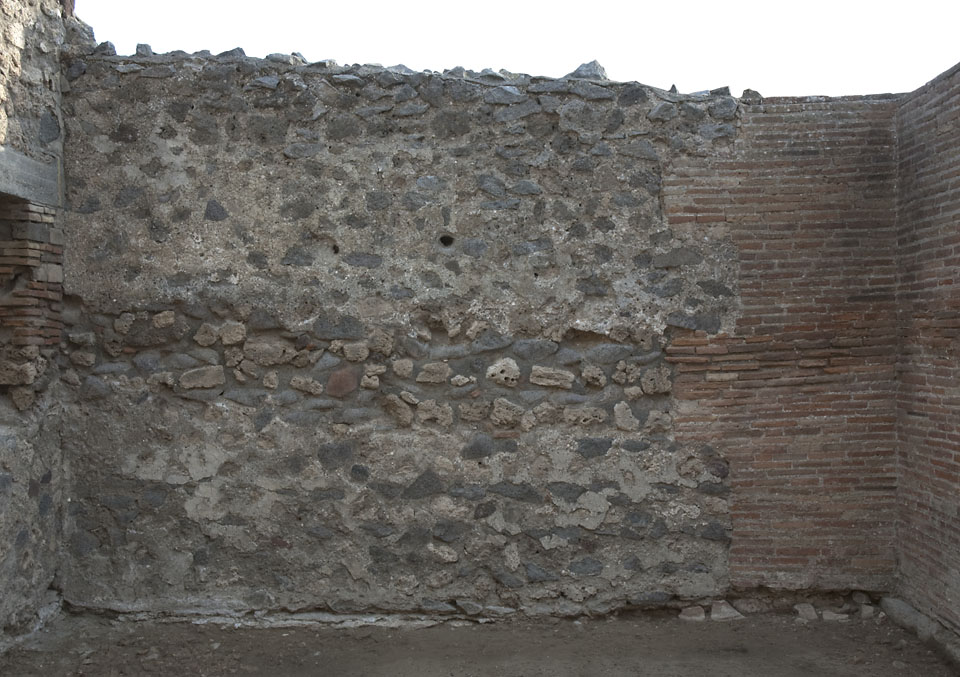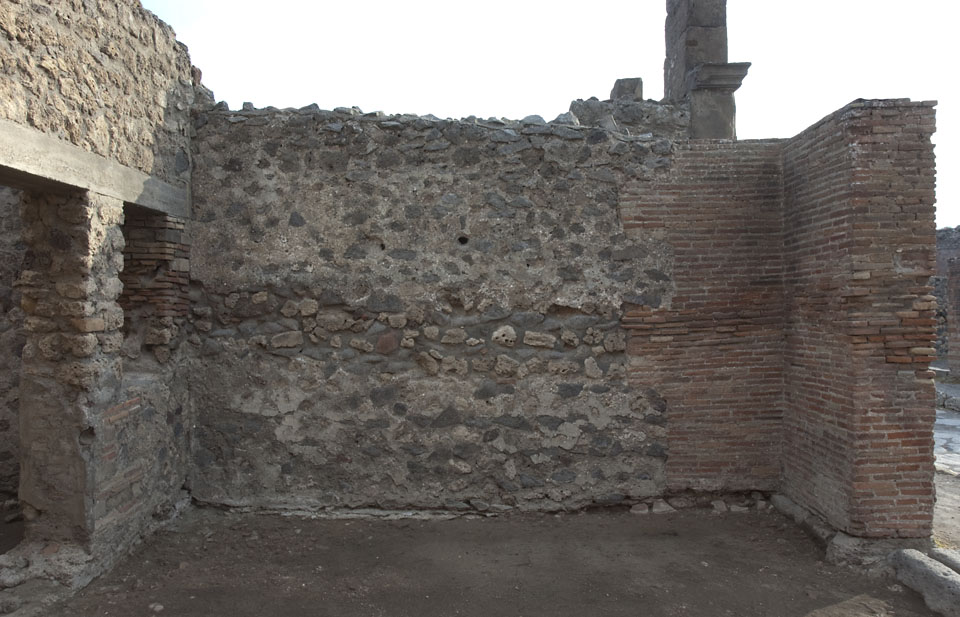East Wall
Description
Susanna Blåndman
The east wall is a continuation of the east wall of room 4. It is also an partition wall making a boundary towards V 1,3. The wall is built in opus mixtum with opus testaceum to the south and opus incertum to the north. The upper 3 - 4 courses of the opus incertum are reconstructed and in a few areas the wall has been reinforced with modern mortar. Scant remains of a porous lime concrete floor abut the wall in a few places.
Opus testaceum
The south part of the wall consists of two different phases. In a 0.78 - 0.88 m wide area from the height of 0.18 m and up to 2.68 m, the wall is built in opus testaceum with two tongues, 1.14 - 1.20 m long, stretching into the opus incertum to the north. The bricks are 0.08 - 0.28 m long and 0.02 - 0.04 m thick, most of them are long. As shown by Thomas Staub, the façade along the entire south part of the insula was originally built in opus quadratum and it has at some point been rebuilt (Staub 2013, 19). The opus quadratum was removed and a brick façade constructed. This has affected the east wall where opus testaceum has replaced opus quadratum in the corner. The current transition from the opus testaceum to the opus incertum is not well executed and the opus testaceum has only two tongues stretching into the opus incertum. The tongues are larger than for example in the east wall of room 4 and the size resembles the size of the quadratum blocks in for example the east wall of the fauces in V 1,3.
Beneath the opus testaceum and partly under the opus incertum, in the lowest 0.18 m of the wall, there is a recess, 0.07 m deep and 0.80 m long, probably from the rebuilding from opus quadratum to opus testaceum. In this recess a block from the opus quadratum is visible. The southernmost part of the wall, a 0.10 m wide aree, is placed on a tufa stone foundation that runs along the south part of the insula.
Opus incertum
The rest of the wall is built in opus incertum, consisting of lava stones, Sarno stones and a few cruma. The main stone used is lava. The area from the height of 1.02 m and up to 1.47 m is badly worn and reinforced with modern mortar. At the bottom of the north half of the wall remains of a porous lime concrete floor abut the wall.
There are almost no spolia in the wall, only a fragment of terracotta. The fragment measures 0.19 x 0.16 m and is located at the height of 1.10 m and at a distance of 1.33 m from the north corner. The mortar in the opus testaceum is brownish and contains grains of lava. In the central part, from the height of 1.32 m and up to 1.44 m the opus testaceum has been reinforced with modern mortar in the northernmost part. In the opus incertum the mortar is greyish containing grains of lava. At the height of approximately 1.10 m and up to 1.50 m the wall is reinforced with modern mortar.
There is a minor patch of supporting plaster in the lower part of the north corner, which is corresponding to a patch on the north wall. The patch is 0.32 m in the corner and 0.05 m high one metre to the south. This patch abuts on the remains of the porous lime concrete floor. The plaster is whitish and contains a larger amount of lava grains.
There are three holes in the wall and they all contain eruption debris. One is located at the height of 1.53 m and at a distance of 2.59 m from the south corner. It measures 0.15 x 0.21 m and is completely filled with eruptions debris. Another hole is located at the height of 1.78 m and at a distance of 1.22 m from the north corner. It measures 0.14 x 0.18 m and is at least 0.08 m deep. The third hole is located at the height of 1.90 m and at a distance of 1.88 m from the north corner. It measures 0.08 x 0.11 m and is at least 0.31 m deep. There is some mortar in the upper inside part of the hole.
H: 3.00 m (N); 2.68 m (S). L: 4.24 m


